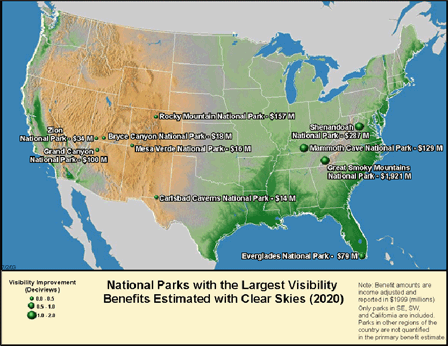Clear Skies
Clear Skies in Tennessee
Highlights of Clear Skies in Tennessee

- Tennessee sources would reduce emissions of SO2 by 55%, NOx by 72%, and mercury by 49% by 2020 due to Clear Skies.
- The health benefits in Tennessee would total $4.8 billion ($870 million under the alternative estimate) and include 600 fewer premature deaths (400 under the alternative estimate) and 1,200 fewer hospitalizations/emergency room visits for asthma.
- In addition, Tennessee would receive environmental benefits including improved visibility and reduced sulfur deposition in the Great Smoky Mountain National Park region.
- Clear Skies does not significantly impact electricity prices. With or without Clear Skies, electricity prices in the electricity supply region that includes Tennessee are expected to remain near 2000 prices.
Clear Skies: An Innovative Approach to Improving Human Health and the Environment
Why Clear Skies?
- Air quality has improved, but serious concerns persist
- Tennessee's citizens suffer ill effects from air pollution, including asthma attacks and premature death
- Electricity generation sector remains a major emissions source
- Very cost-effective to control the power sector, relative to other sources
- Sources are concerned about upcoming complex and burdensome regulations
Advantages of the Clear Skies Approach
- Guarantees significant nationwide emissions reductions - beginning years before full implementation
- Tennessee sources would substantially reduce emissions of SO2, NOx, and mercury
- Delivers dramatic progress towards achievement of critical health and environmental goals
- Uses proven, market-based flexible approach with incentives for innovation
- Recognizes environmental needs as well as industry constraints, allowing industry to better manage its operations and finances while lowering risks to the public
- Sources are projected to install pollution controls to enable continued reliance on coal
- Increases certainty across the board for industry, regulators, and consumers
Under Current Clean Air Act Power Plants Would Face a Complex Set of Requirements
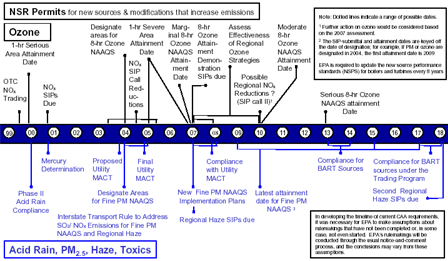
For a larger image, click here.
Clear Skies Sets a Firm Timeline for Emission Reductions
| The existing Title IV SO2 cap-and-trade program provides an incentive and a mechanism to begin reductions upon enactment of Clear Skies years before regulatory action under the current Act. |
2004: The NOx SIP call (summertime NOx cap in 19 Eastern States + D.C.)
2008: Clear Skies NOx Phase I (2.1 million ton annual cap assigned to two Zones with trading programs)
2010:
- Clear Skies Hg Phase I (26 ton annual cap with a national trading program)
- SO2 Phase I (4.5 million ton annual cap with a national trading program)
2018:
- Clear Skies NOx Phase II (1.7 million ton annual cap assigned to two Zones with trading programs)
- Clear Skies Hg Phase II (15 ton annual cap with a national trading program)
- Clear Skies SO2 Phase II (3.0 million ton annual cap with a national trading program)
Emissions in Tennessee under Clear Skies
|
Emissions in Tennessee (2020) would be significantly reduced from 2000 levels:
|
Emissions: Current (2000) and Existing Clean Air Act Regulations (base case*) vs. Clear Skies in Tennessee in 2010 and 2020


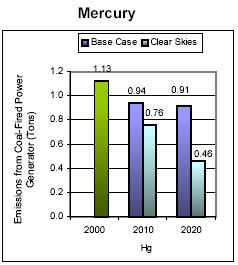
Note: The base case using IPM includes Title IV, the NOx SIP Call, NSR settlements, and state-specific caps in CT, MA, MO, NC, NH, TX, and WI. It does not include mercury MACT in 2007 or any other potential future regulations to implement the current ambient air quality standards or other part of the Clean Air Act. Base case emissions in 2020 will likely be lower due to state and federal regulatory actions that have not yet been promulgated.
SO2 and NOx Emissions Reductions under Clear Skies
|
Emissions in Tennessee and surrounding states would decrease considerably. These emission reductions would make it much easier for Tennessee to comply with the national air quality standards. |


Note: The base case in IPM includes Title IV, the NOx SIP Call, NSR settlements, and state-specific caps in CT, MA, MO, NC, NH, TX, and WI. It does not include mercury MACT in 2007 or any other potential future regulations to implement the current ambient air quality standards or other parts of the Clean Air Act. Base case emissions in 2020 will likely be lower due to state and federal regulatory actions that have not yet been promulgated. Emissions projected for new units in 2020 are not reflected.
Clear Skies Health and Air Quality Benefits in Tennessee
Improve Public Health
| By 2020, Tennessee would receive approximately $4.8 billion in annual health benefits from reductions in fine particle and ozone concentrations alone due to Clear Skies. (see note 1) |
- Reduced ozone and fine particle exposure by 2020 would result in public health benefits of:
- approximately 600 fewer premature deaths each year (see note 1)
- approximately 400 fewer cases of chronic bronchitis each year
- approximately 800 fewer nonfatal heart attacks each year
- approximately 1,200 fewer hospital and emergency room visits each year
- approximately 66,000 fewer days workers are out sick due to respiratory symptoms each year
- approximately 900 fewer school absences each year
- Reduced mercury emissions would reduce exposure to mercury through consumption of contaminated fish, resulting in additional, unquantified benefits for those who eat fish from Tennessee's lakes and streams.
Counties Projected to Remain Out of Attainment with the PM2.5 and Ozone Standards in Tennessee
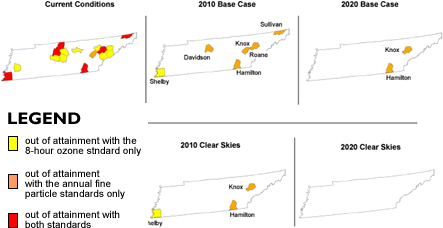
Note: Based on 1999-2001 data of counties with monitors that have three years of complete data. The base case includes Title IV, the NOx SIP Call, the Tier II, Heavy-Duty Diesel, and Nonroad Diesel rules, final NSR settlements as of early spring 2003, and state-specific caps in CT, MA, MO, NC, NH, TX, and WI. It does not include mercury MACT or any other potential future regulations to implement the current ambient air quality standards or other parts of the Clean Air Act.
Clear Skies Would Help Tennessee Meet Air Quality Standards
- Currently there are 7 counties exceeding the annual fine particle
standards and 15 counties exceeding the 8-hour ozone standard.
- Several of these counties are expected to be brought into attainment with the fine particle standards under existing programs.
- All of these counties are expected to be brought into attainment with the ozone standard under existing programs.
- Clear Skies would significantly improve air quality in Tennessee beyond what is expected from existing programs.
- By 2010, Clear Skies would bring 3 of the remaining nonattainment counties (Sullivan, Roane, and Davidson -- population approximately 800,000) into attainment with the annual fine particle standards.
- By 2020, Clear Skies would bring all remaining nonattainment counties (Knox and Hamilton counties -- population approximately 700,000) into attainment with the annual fine particle standards.
- In addition, Clear Skies would reduce ozone and fine particle concentrations in counties attaining the standards throughout the state.
Note: Based on 1999-2001 data of counties with monitors that have three years of complete data.
Clear Skies Environmental Benefits in Tennessee
Clear Skies Would Provide Substantial Environmental Benefits in Tennessee
In comparison to existing programs,
- Visibility would improve perceptibly in the area around Great Smoky Mountain National Park, resulting in $1.9 billion in benefits under Clear Skies by 2020.
- Sulfur deposition, a primary cause of acid rain, would decrease by up to 60% across the eastern half of the state, including Great Smoky Mountain National Park.
- Nitrogen deposition, another significant contributor to acid rain as well as a cause of damage in nitrogen sensitive forests and coastal waters, would decrease by up to 20%.
- Mercury deposition would decrease by 5-15% across much of the state, and by 15-30% in small areas.*
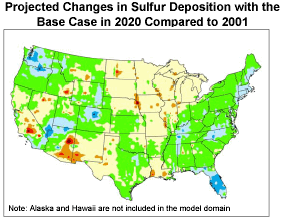
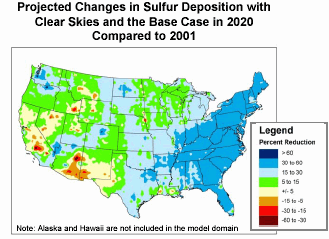
Note: Sulfur deposition in the West is generally low. The large percentage increases correspond to relatively small changes in actual deposition from expected increases in emissions primarily from sources not affected by Clear Skies (e.g., metals processing, petroleum refining, chemical and fertilizer manufacturing). A few power plants are expected to increase emissions slightly under existing programs.
* These results are based on modeling the Clear Skies mercury cap without triggering the safety valve.
Visibility Benefits in National Parks
Airsheds for the Southern Blue Ridge Mountains
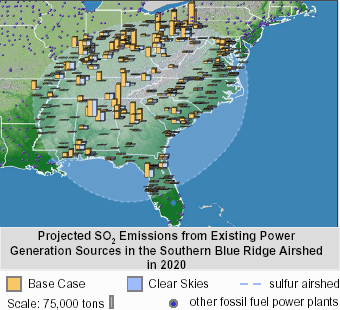

- This section shows regional airshed maps that were developed for the Southern Blue Ridge Mountains (which includes Shenandoah National Park).
- Multiple emission sources in numerous states contribute to air quality degradation and acid deposition in the Southern Blue Ridge region.
- In 2020, emissions from power plants in the Southern Blue Ridge region are projected to be substantially lower with Clear Skies than under the Base Case:
- SO2 emissions are projected to decrease 61%;
- NOx emissions are projected to decrease 68%.

Note: An "airshed" depicts a modeled approximation of a large proportion of sources contributing to air quality in a particular receptor region.
Electricity Generation in Tennessee under Clear Skies
| Current and Projected Generation by Fuel Type in Tennessee under Clear Skies (GWh) |
|
|
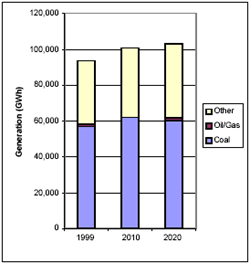 |
|
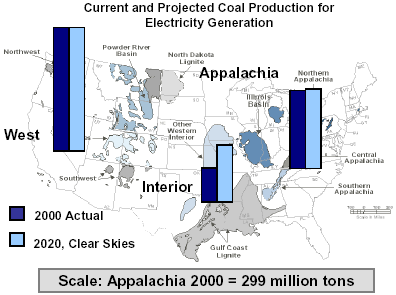
Emission Controls in Tennessee under Clear Skies
|
The major generation companies in Tennessee include:
|
Units in Tennessee Projected to Be Retrofitted Due to Clear Skies by 2020
| Plant Name | Unit ID | Technology |
| ALLEN | 1 | Scrubber |
| ALLEN | 2 | Scrubber |
| ALLEN | 3 | Scrubber |
| GALLATIN | 1 | SCR/Scrubber |
| GALLATIN | 2 | SCR/Scrubber |
| GALLATIN | 3 | SCR/Scrubber |
| GALLATIN | 4 | SCR/Scrubber |
| KINGSTON | 1 | Scrubber |
| KINGSTON | 2 | Scrubber |
| KINGSTON | 3 | Scrubber |
| KINGSTON | 4 | Scrubber |
| KINGSTON | 5 | Scrubber |
| KINGSTON | 6 | Scrubber |
| KINGSTON | 7 | Scrubber |
| KINGSTON | 8 | Scrubber |
| KINGSTON | 9 | Scrubber |
| JOHNSONVILLE | 10 | SCR |
| JOHNSONVILLE | 7 | SCR |
| JOHNSONVILLE | 8 | SCR |
| JOHNSONVILLE | 9 | SCR |
Note: Retrofits and coal-fired capacity apply to coal units greater than 25 MW.
Electricity Prices in Tennessee under Clear Skies
|
|
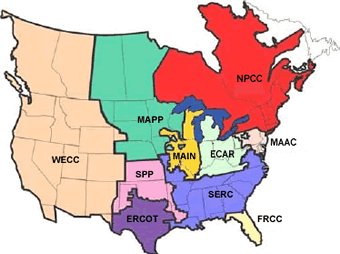

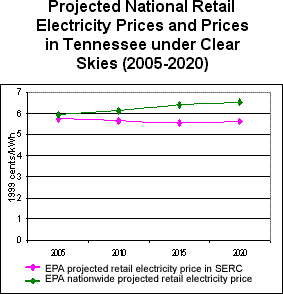
| In 2000, the average retail electricity price in Tennessee was approximately 5.6 cents/kWh, which was below the average national retail price of approximately 6.7 cents/kWh. |
Note: The base case using IPM includes Title IV, the NOx SIP Call, NSR settlements, and state-specific caps in CT, MA, MO, NC, NH, TX, and WI. It does not include mercury MACT in 2007 or any other potential future regulations to implement the current ambient air quality standards or other parts of the Clean Air Act. Base case emissions in 2020 will likely be lower due to state and federal regulatory actions that have not yet been promulgated.
Costs and Benefits in Tennessee under Clear Skies
Benefits Outweigh the Costs
Clear Skies....
|
- In Tennessee, Clear Skies is projected to cost approximately
$145 million annually by 2020 while providing health benefits
totaling approximately $4.8 billion annually.
- The increases in production costs under Clear Skies represent
only a small percentage of total retail electricity sales
revenue in Tennessee.
- Retail electricity sales revenue in Tennessee was over $5.4 billion in 2000.
- Adjusting these sales revenues by the same growth rate used for the modeling of costs would result in revenues of over $8.3 billion annually in 2020.
- The increases in production costs under Clear Skies represent
only a small percentage of total retail electricity sales
revenue in Tennessee.
- Nationwide, the projected annual costs of Clear Skies (in $1999) are $4.3 billion in 2010 and $6.3 billion in 2020; the nationwide benefits of Clear Skies are expected to be over $113 billion annually by 2020.
- An alternate estimate projects annual health benefits totaling $23 billion.
Notes on EPA's Analysis
- The information presented in this analysis reflects EPA's modeling
of the Clear Skies Act of 2003.
- EPA has updated this information to reflect modifications:
- Changes included in the Clear Skies Act of 2003.
- Revisions to the Base Case to reflect newly promulgated rules at the state and federal level since the initial analysis was undertaken.
- The Clear Skies modeling results presented include the safety valve feature
- This analysis compares new programs to a Base Case (Existing Control Programs), which is typical when calculating costs and benefits of Agency rulemakings.
- The Base Case reflects implementation of current control programs
only:
- Does not include yet-to-be developed regulations such as those to implement the National Ambient Air Quality Standards.
- The EPA Base Case for power sector modeling includes:
- Title IV, the NOx SIP Call, NSR settlements, and state-specific caps in Connecticut, Massachusetts, Missouri, New Hampshire, North Carolina, Tennessee, and Wisconsin finalized before March 2003.
- For air quality modeling, the Base Case also includes federal and state control programs, as well as the Tier II, Heavy Duty Diesel, and Nonroad Diesel rules.

|
State information based on EPA's modeling of the Clear Skies Act of 2002 is presented here for archival reasons.
|
1. An alternative methodology for calculating health-related benefits projects approximately 400 premature deaths prevented and $870 million in health benefits each year in Tennessee by 2020.

